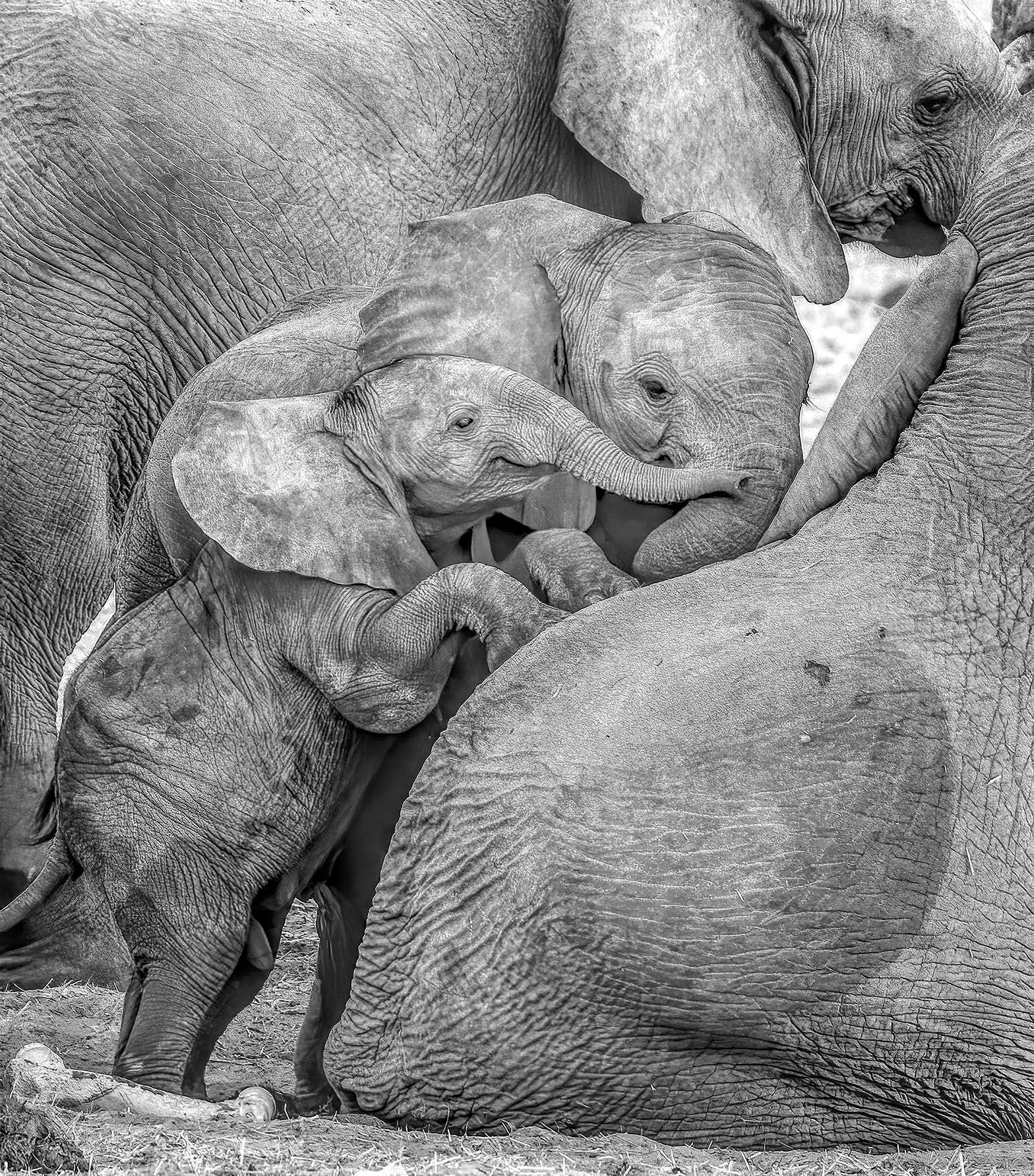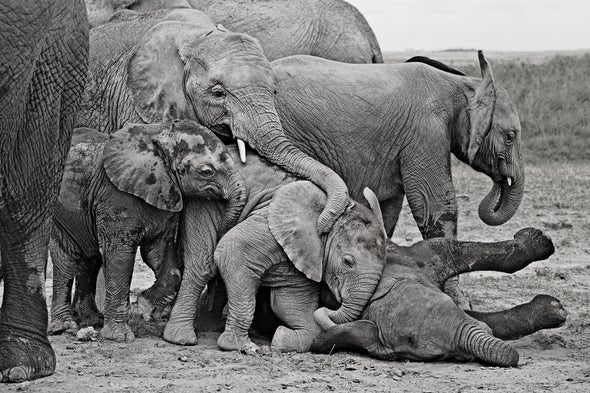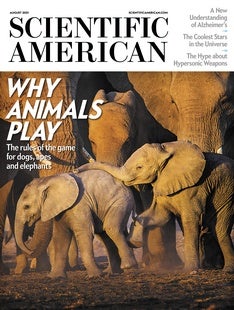It was late afternoon in the winter scrub desert within Namibia’s Etosha National Park when I spotted a family of elephants on the southern edge of the clearing. I was scanning the horizon from the observation tower where my colleagues and I conduct our research at Mushara water hole. Wind had deterred elephant families from visiting the water hole earlier—it interferes with their efforts to keep tabs on one another vocally—but with the air now still, our first customers of the day had finally appeared.
Judging from how many trunks were stretched high, sampling the air, the group was itching to break cover and run for the water. The young males were particularly anxious to get going. Not only were they thirsty, but they had a lot of sparring to catch up on. As winter wears on, the environment dries out, and elephants have to venture farther from water to find enough to eat. Several days may pass before they can return to the water hole for a drink and a reunion.
I could see why this group was holding back, however. Another elephant family was amassing in the southeastern forest and heading our way, and the adult females were wary. They stood with their feet firmly planted, ears held straight out, as they sniffed what little remained of the prevailing wind for any potential danger. Not only would exiting the security of the forest expose the family to predators, but an encounter with a higher-ranking elephant family could result in an aggressive interaction. For the youngsters in the group, however, more families meant more opportunities to play. So after thoroughly assessing the clearing, the matriarch gave the word with a rumble and an ear flap, and the family began its approach to the water.
Late afternoon is my favorite time of day during our field season in the austral winter—the air cools fast as the sun sinks low in the sky, painting the elephants a radiant pink. My colleagues and I stand in the observation tower with a celebratory drink in hand, our binoculars trained on the horizon, hoping for a sunset visit like this one from one of our beloved resident families. During these daily visits, I always learn a new lesson about elephants—particularly when they play.
I have witnessed the important role of play in calf development and family politics by watching members of my favorite elephant groups frolic at this water hole at sunset. These often chaotic observations inspired me to want to understand more about how animals play and what advantages this behavior might confer, not just to elephants but to all social creatures, including humans. It turns out that play, like other forms of interaction, has rules of engagement. And it is essential for developing the physical and cognitive faculties that animals need to survive and reproduce.
Rules and Regulations
People tend to think of play as an activity one engages in at one’s leisure, outside of learning important skills needed to succeed later in life, such as hunting, mating, and evading predators. But although playing is fun for all involved—and fun for those who are watching—play behaviors evolved as ritualized forms of survival skills needed later in life, providing the opportunity to perfect those skills.
Engaging in play allows animals to experiment with new behaviors in a protected environment without dangerous consequences. The unwritten code of conduct surrounding play lets them explore many possible outcomes.
Animals learn the rules of engagement for play at a very young age. Among dogs, the bow is a universal invitation to engage in silliness that triggers the same bowing down and splaying of the front legs in the receiver of the signal—inevitably followed by chasing and pretend biting. Chimpanzees and gorillas motivate others to romp by showing their upper and lower teeth in what primatologists refer to as a play face, which is comparable to human laughter.



When a young male elephant wants to play with another male of similar age, he holds his trunk up and presents it to the other as an invitation. Most often his next move would be to place his trunk over the other’s head, which in adults signals dominance but in calves is guaranteed to precipitate a spirited sparring match. These encounters run the gamut from gentle shoving to intense headbutting and pushing back and forth with trunks entwining and tusks clacking. The fun continues for seconds to minutes for youngsters; for older teens and young adults, it can go on much longer. The sparring matches provide bulls with the opportunity to test their fighting ability so that they might successfully compete for a female when they reach sexual maturity and enter the hormonal state of musth around the age of 25.
When a young male elephant is feeling particularly adventurous, he may venture far away from Mom’s protection to invite a distant relative to spar. If his foray takes him too far away or if a spar turns unexpectedly rough, the brave calf will lose his nerve and often will run quickly back to Mom’s side with ears flapping and trunk yo-yoing as he retreats.
Occasionally an older sister will oversee a play bout between youngsters. These ever watchful siblings form part of an extended caretaking network that facilitates play, but its members also will intervene if a calf crosses an invisible bloodline and gets deflected with a trunk slap by an overly protective, high-ranking mother.
Forms of Play
Scholars of animal behavior recognize three main categories of play. The first is social play, which is any kind of antic that involves others. The second is locomotive play—including running, walking, jumping and pouncing—which facilitates lifelong motor skills. In prey species, locomotive play helps perfect predator-avoidance tactics such as the springbok’s “pronking” high into the air while running as a herd and landing in unpredictable spots. In elephants, it hones predator-avoidance skills, as well as strategies for escaping an aggressive suitor or a competitor looking to inflict a mortal wound. Conversely, young predators such as lion cubs use locomotive play to sharpen their hunting ability. Chasing and tripping littermates and then giving them a good chew on the spine or throat are rehearsals of the skills needed to catch prey animals and dispatch them by severing their spinal cord or choking them.
Many species, including our own, engage in the mock-fighting variety of locomotive play, which allows them to test their strength in a safe environment where everyone understands the rules. A playful spar in elephants is just like an arm wrestle between human peers. When play becomes more elaborate and determined, it turns from an arm wrestle into something akin to martial arts, allowing both participants to practice skills and develop innovative solutions that could help them avoid mortal combat later in life. Play fighting also provides opportunities to test boundaries, gauge who can be trusted and learn important body language.
The third main category of play is object play, which incorporates objects from the environment into the cavorting. For an elephant, this object might take the form of a stick or branch that the elephant explores, carries or throws with its trunk. In captivity, elephants enjoy playing with balls or hauling inner tubes around for fun. Alternatively, the object could be another animal, such as a zebra or giraffe, that offers an irresistible opportunity for a chase. In one case, a four-year-old male calf named Leo taught his baby brother, Liam, just how fun such a chase can be, leaving Liam scrambling to keep up with Leo’s charge as a giraffe made a quick escape.
Two other forms of play have only been documented in great apes, including humans. One of these, game playing, combines social, locomotive and object play. Sports such as soccer, field hockey, lacrosse and polo are examples of traditional games that became formalized as sports with specific sets of rules (among nonhuman great apes, only captive individuals raised in human contexts play formal games). The other variety of play that appears to be unique to great apes is make-believe. For example, a wild chimpanzee may carry around a small log, pretending it is an infant. A human child might play with an invisible toy or set up an invisible barrier that they want adults to acknowledge.
Not Just Fun and Games
Play provides an environment for experimenting with risk. When a lion cub deliberately gives up some control over its body, it puts itself at a disadvantage, allowing others to succeed in pouncing on it. Marc Bekoff of the University of Colorado Boulder and his colleagues have proposed that play increases the versatility of movements used to recover from a loss of balance and enhances the ability of the player to cope with unexpected stressful situations. The goal is not to win but to improve skills, sometimes by self-handicapping.
Once a cub has been tackled by its littermates, roles might reverse such that a littermate handicaps itself, allowing the other cub to tackle it in return. Self-handicapping is risky and requires trust, but it is a great way to develop strength and agility. It is also an important exercise in building cooperation. In the Sawtooth wolf pack raised by Jim and Jamie Dutcher in the Sawtooth Mountains in Idaho, the dominant wolf would slow down to allow a close companion that happened to be a subordinate to catch up and tackle him. In elephants, on a number of occasions I have seen older male calves crouch down to allow a much younger calf to spar with them. This is akin to an older brother handicapping himself during an arm wrestle by not using all of his strength to let his little brother win.


Being silly is another important aspect of play, one that gets us outside our comfort zone and forces us to test new strategies. Silliness in our movements, behavior and even language helps us think much more broadly and creatively. Problem-solving derived from the silliness of play has been demonstrated in many species and even in robots. When computer scientist Hod Lipson of Columbia University gave his artificial-intelligence robots a chance to play—by dancing around in random movements—they outperformed other robots when challenged with the unexpected. The positioning information garnered from moving around randomly led one robot to come up with creative solutions for maintaining its balance after losing a limb. Likewise, when sea lions play in the surf, they often project themselves high into the air midway down the face of monster waves, like those that roll into Santa Cruz. These are just the kinds of behaviors needed to avoid an attack by a great white shark—their primary predator apart from killer whales and humans.
Play also builds trust. Thomas Bugnyar of the University of Vienna in Austria and his colleagues found that ravens pretend to cache highly valued food items and then watch how other ravens respond, apparently to determine whom they can trust. Learning how to differentiate competitors from likely reliable collaborators early on has obvious advantages, whether one wants to gain allies or build a coalition within a group—or repair broken relationships.
Families Reunited
“Incoming from the southeast!” I called out from the Mushara tower as my elephant field team narrowed in on what looked like a dusty line of pinkish-gray boulders amassing on the edge of the clearing one afternoon during our 2018 field season. The search for identifying features began. A missing tusk, a notch in the bottom of the left ear, or a V-shaped cut in the top of the right ear would give the family away. Whoever identified the elephant family first would get an extra sundown drink.
That day the incoming family turned out to be the Actors. It was our first sighting of the group that season, and we were excited to see a new addition to the family: high-ranking Susan, identified by her daggerlike left tusk, had a new male calf, Liam. And low-ranking Wynona, who was missing her left tusk, had her two-year-old calf Lucy in tow. We had been following the contentious dynamic between these two mothers very closely over the years, particularly during the 2012 season when each had a calf—Leo and Liza, respectively.
Susan had relentlessly tormented Wynona all the way up to the end of her pregnancy, aggressively charging her whenever she got close to the water to drink. The tension was so high that when Wynona broke away from the family to give birth, surrounded by her daughter Erin and their calves, I worried for her baby’s life if a reunion were to take place. Sure enough, there was no fanfare and no reunion that we witnessed to present her new baby to the rest of the family. I assumed then that Wynona’s days as a member of the Actor family were numbered.
As predicted, Wynona did separate from the larger family and became the matriarch of her own core family. It went on like that for four years until the arrival of Wynona’s newest baby, Lucy, in 2016 yet again changed the dynamic of the larger extended family group. Play appeared to be an important contributing factor in reuniting the family.

Lucy’s older sister, Liza, had been a shy baby who stuck to her mom and her very close relatives. Wynona timed her movements to avoid too much overlap with the larger family group when they went to Mushara water hole to drink. They tended to be one day behind or ahead of the Actor family, usually behind. On the rare occasion that they did overlap just at the end of the extended family visit, Liza did not stray to interact with the larger family. And who would blame her? Susan was right there with a quick jab with her dagger tusk or a trunk slap, whichever was more convenient, making it clear that the low-ranking babies had no place on the playground with royalty. There was hardly a chance for calves of Wynona’s small but growing family to get to know members of the extended family.
Lucy changed all that. From the start, she was quite the extrovert. Maybe being born into a very small family made her all the more curious and excited by the opportunity to engage with the extended family on the infrequent occasion of their overlapping. And she was not deterred by the admonishments of high-ranking moms within the extended family, much to the seeming annoyance of the ever watchful Susan.
Now the two-year-old Lucy knew just how to run through adults’ legs and out of trunk’s reach, navigating potential minefields and dodging her mom’s attempts to rein her in. She behaved more like Susan’s calf, Leo, who was her older sister Liza’s contemporary. When we scored Leo’s distance from his mom at the water hole, he always had a much higher score than Liza. We had assumed that was attributable mainly to his sex and the male elephant’s early experiments with independence. But the arrival of Lucy showed us that the story was not that simple.
Lucy spent a lot of time a great distance away from her mom and played with calves of mothers of all ranks. When it came time to leave the water hole and go in separate directions, as dictated by the prevailing family politics, Lucy made that impossible. She was so busy playing with other calves that there was no extracting her, leaving Wynona no choice but to modify her behavior.
Instead of continuing on her premeditated departure route, in the opposite direction from the Actor family, Wynona, her eldest daughter Erin and their calves turned around and followed the rest of the family so that Wynona did not risk losing her new calf. There was no guarantee that the other mothers would protect Lucy, much less allow her to suckle, as that would mean fewer precious nutrients for their own calves. But by 2018 Wynona was fully reintegrated into the Actor family, whether she wanted to be or not.
Every time I see this dynamic unfold, it makes me smile. How often is it the case in our own families where grudges of older generations are put aside because of the bonds forged by the next generation through play?
Play should be on our daily agenda. Smiling and laughing are contagious behaviors that facilitate bonding, are curative and, most important, do not have to take up much time. The next time you feel like you are too busy to play a frivolous game at work or you don’t want to face that family reunion, make the time and muster the will. You might be surprised at the outcome, whether it be a better idea for a pitch meeting or the dissolution of a long-standing barrier between you and a contentious relative thanks to a good giggle.
Our highly adaptable and innovative nature is rooted in play. I am grateful to my favorite elephant, Wynona, and her daughter Lucy for reminding me that there is always something new we can learn from it—and that we are never too old to internalize those lessons. A good romp can pay off in ways I hadn’t anticipated. It forges new bonds, reunites divided families, improves coping skills and overall health, and facilitates cooperation and innovation. Given all these benefits, how could we afford not to play?



